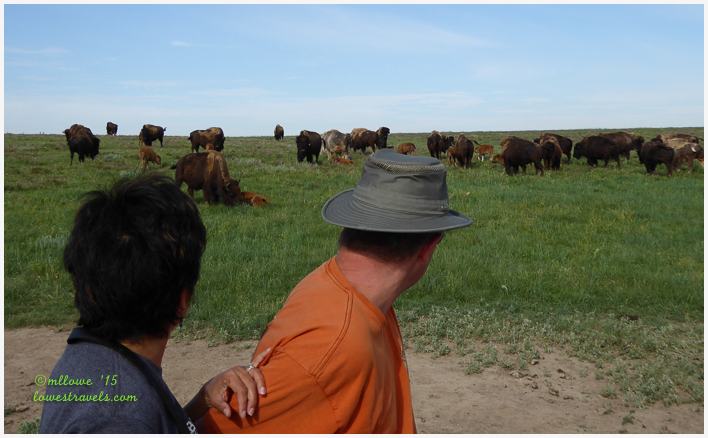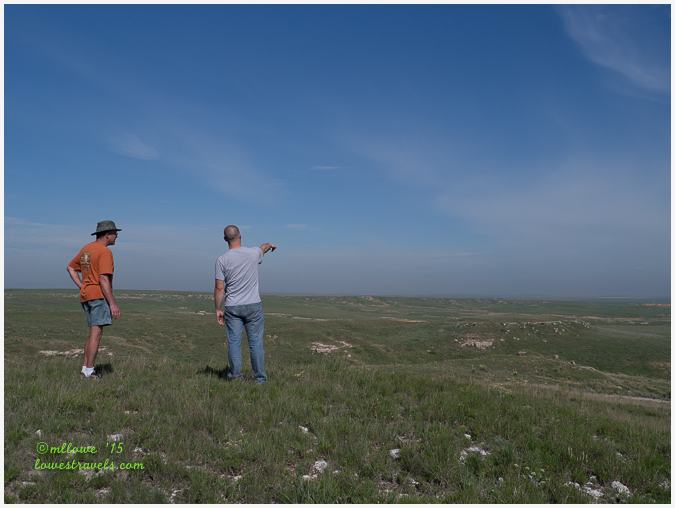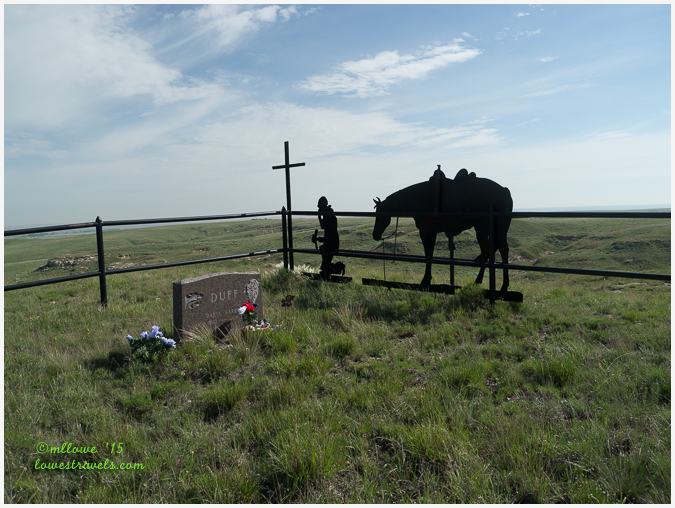While out here in rural Kansas, we had an opportunity to get up close and personal with some magnificent bison. We learned about a “bison ranch tour” that Duff Ranch offered, just up the road from our home base at Lake Scott State Park (Steve’s review here). It definitely sounded like something unique and interesting, so we jumped in the car and headed up there one morning.
When we arrived, we got to sit in the back of their flatbed truck so we could get an unimpeded view of the huge bison. We learned several facts about these animals from Gentry, our rancher/tour guide. For one, they are often mistakenly referred to as buffaloes. These imposing specimens are American Bison, symbolic animals of the Great Plains.

Once upon a time, bison roamed in massive herds all across the Great Plains of the United States and into Canada. They were critically important to the Plains Indian tribes as a source of food, clothing and other needed items. Then, when the Euro-American settlers came onto the scene, they were slaughtered by the millions to intentionally starve the Indians out.

Today, the bison have made a comeback through good management, and approximately 500,000 exist mostly raised as livestock on ranches. About 30,000 are managed for conservation in private and public herds, in national parks, preserves and tribal lands. The popular herd in Yellowstone National Park is one of the few that remains genetically free of cattle genes.

A surprising fact that I learned during the tour was that bison can be raised as livestock – silly me, where did I think that bison ribeye steak I had in Denver came from, somebody spearing it from a running horse on the prairie? You see, the first time I’d seen these majestic animals was in the wild at Yellowstone NP.

The Duff family has been raising bison since the owner’s grandfather leased about 3,500 acres of land for the herd to graze. They can roam great distances as they graze, since they don’t require water with the frequency that cattle do. Bison mainly eat grasses and sedges, but their favorite is Buffalo Grass, a short grass that’s abundant on the prairie. Gentry told us the average lifespan of these animals is 20-25 years.


Gentry helped us distinguish the cows (females) from the bulls (males), as both have horns. The cow’s horns curve inward, while the bull’s stick out straighter and have a thicker base.
He also mentioned that in 1994 one of their cows gave birth to a bull with white markings. DNA testing confirmed that the sire was a bull they had purchased from Custer State Park in the Black Hills of South Dakota. The test showed no sign of cattle genes, and they have always considered the white coloring to simply be a unique pigmentation.

As we drove around the pasture we noticed that the calves were hanging close to their moms. They have a light reddish/brown coat and look more like a regular cow, since they lack the distinctive hump and horns of the adult bison.

After we ran out of snacks for them, the herd pretty much ignored us. Maybe they knew our one-hour tour was about over? We were ready to leave anyway, as the mosquitoes were feasting on our arms and legs by then.

We were also surprised to learn that although the family sells bison meat to consumers through their website, their main income source is through selling yearlings to people who want to raise their own animals. In fact, they sell the meat of only 2-3 bison a year. We bought a couple of their grass-fed bison steaks, and I can tell you it’s probably the most fantastic meat that’s ever come off our barbecue!



The bison we saw may not be wild, but it was still really cool and a bit scary to be so close to them. I’m sure glad I didn’t fall off the truck! This was one of those little side-trips that turned out to be a great way to meet local folks who actually run a large ranch. We asked a lot of questions and got a feel for what life is like out here on the plains. What an exciting and interesting morning we had on the ranch!



What a great way to see bison up close and personal!
I had a time of my life and a scare one too.
We are hanging out at Custer State Park these days and I was shocked to see them called buffalo in all of the parks literature. And just recently at Wind Cave National Park (just down the road) we had learned they are properly called bison!
I corrected myself now that I learned they are really bison not buffalo.
What a great experience! I love that first photo of the bison and your expression when that big girl was eyeing you.
Cool views of the bison Mona Lisa and one of them definately took a fancy to you!
Great way to get up close and personal with these beautiful creatures. What a fun time on the farm:)
What an adventure!
Nina
Very interesting, Mona Liza. A great write-up on the history of bison, I just love those animals!
That adventure was worth the visit to Kansas. How fun and fantastic photos 🙂
Wow, bison look impressive and slightly intimidating at very close range. It’s great to see so many there. It doesn’t matter that they aren’t in the wild. Great pics! 🙂
The rancher kept reminding me not to be complacent for they could be dangerous.
What a terrific idea. I have never seen a herd up that close. The look on your face even from the side is priceless. Interesting that they have a white bison. I understood they were very rare and really sacred to Native Americans. Great post. I loved reading it.
Very cool tour … one that I would like to do one day. Thanks for the advance warning on the mosquitoes.
What an interesting tour! I learned a lot about bison that I didn’t know from reading your post. We had up close encounters with bison in Yellowstone while we were hiking — so interesting that the bison there are one of the few herds free of cattle genes.
We had fun despite the darn mosquitoes, they were deadly. But the bison are really interesting to watch as they followed us.